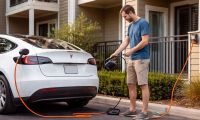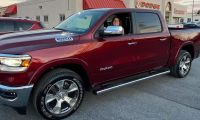Over the course of this weekend, I got to spend three great days driving a Mitsubishi i MiEV and amply tested the recharge procedures using all three levels, 1, 2 and CHadMO. It was not only easy to use, it was fast, convenient and yes, stress free. But we are a society of convenience and as car witness an increasing number of cup holders, we are slowly moving away from cables to make EVs even more practical by using inductive charging.
Wireless Charging Unshackled At EVS26. I’ll be at the EVS26 next week where the title of the symposium could easily have been: “Unshackle the cord!” The industry is hearing you and working on how to allow you to drive your electric car over a parking spot and recharge… wirelessly. Siemens, Qualcomm Halo, Evatran, to name a few will show their latest break through.
Evatran Wireless Charging. Evatran develops Plugless Power wireless recharging technology for electric vehicles, EVs and will be at the will EVS26 next week in Los Angeles at the Convention Center. Their Plugless Power technology will show how a hands-free charging system can charge a Nissan LEAF and a Chevrolet Volt. With the launch of their Apollo Trial Program, the initiative aims to encourage a wide EV adoption with the wireless charging technology trials. Prototypes used in the Apollo Program on LEAF and Volt vehicles will be at their booths at the symposium where you can witness the alignment process, and see object detection technology. Evatran will promote the next phase of its Apollo Trial Program, inviting commercial partners Hertz, Google, and Duke Energy to try its wireless charging system on their own electric vehicles.
Siemens Induction. While wireless charging might be a technology you find in your home, installing systems to recharge EVs is another story. Currently another big player in the industry is Siemens who is working on prototypes that are shrinking sizes of coils and making alignment seamless. I had a chance to hear Rick Kluth, the Product Portfolio Manager for Electric Vehicle Infrastructure, Siemens in charge of Inductive Charging. It’s no secret that simplifying and enabling inductive charging means easy mass adoption. By using two coils of the same size with the primary on the ground connected to the energy grid, the other coil would be in your EV and would “receive” electrons, charging the battery pack. By both positioning themselves over each other perfectly, they would mean safety and convenience for EV drivers.
In a proof of concept called IndiOn Project, Siemens and BMW proved that EV integration, the positioning system, the closed loop control, communication and non-interference with other components have yielded great results. As future coil design will become smaller and lighter, it will go down from its current 60 centimeter size so that the 2nd generation will be half as much with less weight. So far their inductive charging project has proven 90% efficient up to 3.5 kW.
Qualcomm & Halo. What does a chipmaker have to do with electric cars? For one thing EVs are a rolling IT platform and a chipmaker with a lot of experience in the cell phone industry knows a thing or two about charging batteries. Hence the November 08, 2011 press release stating that Qualcomm Incorporated acquired almost all of the technology and other assets of HaloIPT, a leading provider of wireless charging technology for electric road vehicles. The HaloIPT team members have joined Qualcomm’s European Innovation Development group based in the UK and have been working on something I’m told we will want to know.
Now that EVs are proving to be practical and reliable, the next hurdle is to lose the cord and to go wireless. With how much wireless capabilities have brought to the cell phone industry and how that is starting to change the closed world of HiFi, it’s no wonder players in the industry are developing practical inductive charging solutions. As more and more manufacturers develop their inductive wireless charging systems, recharging your EV on the go will be as simple as dropping your electric toothbrush into its charging slot.












Comments
This is a really interesting
Permalink
This is a really interesting article about the future of EV charging and the realistic possibilities in the future. While this type of technology does not yet exist there are other forms of technology which have and are being developed in order to allow EV users additional information and convenience. Sites which provide real time data about available charging points such as Plugsurfing are a perfect example of this, as they allow EV owners to effectively track down charge points in their local area before they start a journey or from their smart phones.
There is research going on at
Permalink
There is research going on at Stanford that uses very high frequency tuned resonant circuitry to charge wirelessly. Efficiencies are very high but at least importantly is that outside of the tuned circuits, there is little chance of leakage or accidental releases of unintended energy that might be possible simply by placing an iron object near the field. This is a major safety issue that always needs to be addressed.